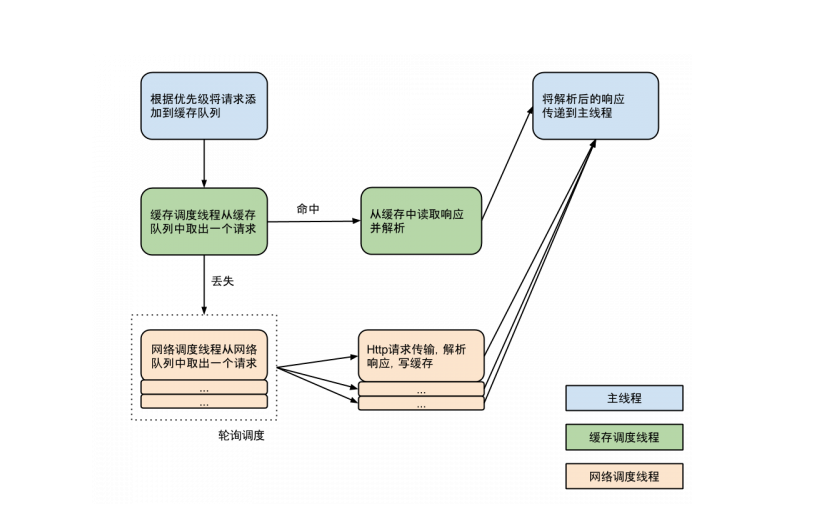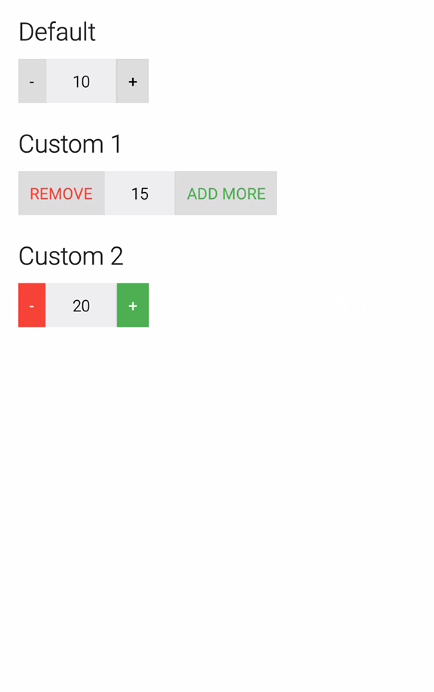編輯:關於Android編程

public static RequestQueue newRequestQueue(Context context, HttpStack stack) {
File cacheDir = new File(context.getCacheDir(), "volley");
String userAgent = "volley/0";
try {
String network = context.getPackageName();
PackageInfo queue = context.getPackageManager().getPackageInfo(network, 0);
userAgent = network + "/" + queue.versionCode;
} catch (NameNotFoundException var6) {
;
}
if(stack == null) {
if(VERSION.SDK_INT >= 9) {
stack = new HurlStack();
} else {
stack = new HttpClientStack(AndroidHttpClient.newInstance(userAgent));
}
}
BasicNetwork network1 = new BasicNetwork((HttpStack)stack);
RequestQueue queue1 = new RequestQueue(new DiskBasedCache(cacheDir), network1);
queue1.start();
return queue1;
}
首先確定一個Volley網絡緩存文件夾交給DiskBasedCache去處理,而DiskBasedCache是Cache的唯一實現,具體實現,這裡我們不關心。然後根據Android的版本號去選擇要使用的處理請求的方式,3.0之前的用HttpClient,3.0以後就用HttpUrlConnection。然後交給BasicNetWork,通過我們的BasicNetWork生成RequestQueue,用到了適配器模式。
2.構造請求隊列
public RequestQueue(Cache cache, Network network, int threadPoolSize, ResponseDelivery delivery) {
this.mSequenceGenerator = new AtomicInteger();
this.mWaitingRequests = new HashMap();
this.mCurrentRequests = new HashSet();
this.mCacheQueue = new PriorityBlockingQueue();
this.mNetworkQueue = new PriorityBlockingQueue();
this.mCache = cache;
this.mNetwork = network;
this.mDispatchers = new NetworkDispatcher[threadPoolSize];
this.mDelivery = delivery;
}
一起來看看它的構造方法,好多屬性要初始化。沒關系,弄懂他們就對Volley的理解差不多了。
mSequenceGenerator:是一個序列號生成器,算是對Request的一個標識。 mWaitingRequests : 這是一個Map容器,裡面維護了一個隊列。這個是Volley對於緩存請求的一個策略,後面就知道了。 mCurrentRequests : 這個是當前請求的Request,看到名字就知道啥意思了。 mCacheQueue : 這是一個緩存隊列,我們請求就會放到緩存隊列中,如果這裡面有就不用去從網絡上請求了。 mNetworkQueue : 這個是網絡請求隊列,是要從這個隊列上取Request去請求網絡的。 mCache:這是我們之前傳進來的DiskBaseCache,硬盤緩存。 mNetwork:這個就是我們之前傳進來的BasicNetwork,其實就是出去Http連接的封裝而已。 mDispatchers : 這個稱之為網絡請求分發者,就是從網絡請求隊列中獲取Request,並且處理的。mDelivery : 這個是執行傳達者,就是每當我們的請求處理完成之後,就是通過它告知我們的UI線程的,從而完成更新。
那麼,mDelivery是怎麼通知我們UI線程呢,其實就是封裝了一層Handler。
public RequestQueue(Cache cache, Network network, int threadPoolSize) {
this(cache, network, threadPoolSize, new ExecutorDelivery(new Handler(Looper.getMainLooper())));
}
看,ExecutorDelivery是mDelivery的具體實現,就是通過獲得了主線程的Looper,然後把消息丟到MQ中,讓Handler從主線程中的Looper中去取消息。當然還有個重要的屬性沒有介紹,就是mCacheDispatcher,這個是下面個步驟才初始化的,它就是緩存分發者,就是從我們之前介紹的mCacheQueue 隊列中獲取Request的。
3.開始輪循
public void start() {
this.stop();
this.mCacheDispatcher = new CacheDispatcher(this.mCacheQueue, this.mNetworkQueue, this.mCache, this.mDelivery);
this.mCacheDispatcher.start();
for(int i = 0; i < this.mDispatchers.length; ++i) {
NetworkDispatcher networkDispatcher = new NetworkDispatcher(this.mNetworkQueue, this.mNetwork, this.mCache, this.mDelivery);
this.mDispatchers[i] = networkDispatcher;
networkDispatcher.start();
}
}
這裡,雖然代碼很簡單,但是做的事情卻很多,這裡將緩存分發者和網絡分發者都啟動了,那麼這些分發者是什麼呢?這些分發者都是繼承了Thread類,就是我們調用了RequestQueue.start()方法,啟動了這麼多線程,其中緩存線程是一條,網絡請求線程默認是4條,一共啟動了5條線程。
4.添加請求
public Request add(Request request) {
request.setRequestQueue(this);
Set var2 = this.mCurrentRequests;
synchronized(this.mCurrentRequests) {
this.mCurrentRequests.add(request);
}
request.setSequence(this.getSequenceNumber());
request.addMarker("add-to-queue");
if(!request.shouldCache()) {
this.mNetworkQueue.add(request);
return request;
} else {
Map var7 = this.mWaitingRequests;
synchronized(this.mWaitingRequests) {
String cacheKey = request.getCacheKey();
if(this.mWaitingRequests.containsKey(cacheKey)) {
Object stagedRequests = (Queue)this.mWaitingRequests.get(cacheKey);
if(stagedRequests == null) {
stagedRequests = new LinkedList();
}
((Queue)stagedRequests).add(request);
this.mWaitingRequests.put(cacheKey, stagedRequests);
if(VolleyLog.DEBUG) {
VolleyLog.v("Request for cacheKey=%s is in flight, putting on hold.", new Object[]{cacheKey});
}
} else {
this.mWaitingRequests.put(cacheKey, (Object)null);
this.mCacheQueue.add(request);
}
return request;
}
}
}
我喜歡直接看重點,如果開發者設置了不緩存,那麼直接將這個Request丟到網絡請求隊列,讓網絡請求分發者去處理,如果設置了緩存,那麼如果mWaitingRequests中沒有鍵的話,直接丟到緩存隊列中,讓緩存分發者去處理,同時把mWaitingRequests的值置為空,先開始,這裡我也沒理解,後來斷點調試了之後才明白。第一次請求進來,mWaitingRequests肯定是空,那麼就丟到緩存隊列中去了,第二次在進來,我們的mWaitingRequests中已經有key了,那麼Request就到了我們mWaitingRequests的key中維護的列隊中去了。這樣是為了防止多次網絡請求,節省流量,這是一種策略,如果我們的mWaitingRequests中有key的話,那麼我們的請求正在處理。那麼,你可以會問,那麼觸發了一個請求,然後過了幾秒還觸發了一個請求,那你不是攔截麼,其實,在Request處理完成之後,分發者們會調用Request中的RequestQueue中finish()方法,會清空mWaitingRequests所有的緩存。
void finish(Request request) {
Set var2 = this.mCurrentRequests;
synchronized(this.mCurrentRequests) {
this.mCurrentRequests.remove(request);
}
if(request.shouldCache()) {
Map var7 = this.mWaitingRequests;
synchronized(this.mWaitingRequests) {
String cacheKey = request.getCacheKey();
Queue waitingRequests = (Queue)this.mWaitingRequests.remove(cacheKey);
if(waitingRequests != null) {
if(VolleyLog.DEBUG) {
VolleyLog.v("Releasing %d waiting requests for cacheKey=%s.", new Object[]{Integer.valueOf(waitingRequests.size()), cacheKey});
}
this.mCacheQueue.addAll(waitingRequests);
}
}
}
}
這樣,就很清楚了,Request中維護了一個RequestQueue對象,從而在處理完成了之後調用RequestQueue中的finish方法。至於Request什麼時候調用的,接著看。
5.緩存分發者
public void run() {
if (DEBUG) VolleyLog.v("start new dispatcher");
Process.setThreadPriority(Process.THREAD_PRIORITY_BACKGROUND);
// Make a blocking call to initialize the cache.
mCache.initialize();
while (true) {
try {
// Get a request from the cache triage queue, blocking until
// at least one is available.
final Request request = mCacheQueue.take();
request.addMarker("cache-queue-take");
// If the request has been canceled, don't bother dispatching it.
if (request.isCanceled()) {
request.finish("cache-discard-canceled");
continue;
}
// Attempt to retrieve this item from cache.
Cache.Entry entry = mCache.get(request.getCacheKey());
if (entry == null) {
request.addMarker("cache-miss");
// Cache miss; send off to the network dispatcher.
mNetworkQueue.put(request);
continue;
}
// If it is completely expired, just send it to the network.
if (entry.isExpired()) {
request.addMarker("cache-hit-expired");
request.setCacheEntry(entry);
mNetworkQueue.put(request);
continue;
}
// We have a cache hit; parse its data for delivery back to the request.
request.addMarker("cache-hit");
Response response = request.parseNetworkResponse(
new NetworkResponse(entry.data, entry.responseHeaders));
request.addMarker("cache-hit-parsed");
if (!entry.refreshNeeded()) {
// Completely unexpired cache hit. Just deliver the response.
mDelivery.postResponse(request, response);
} else {
// Soft-expired cache hit. We can deliver the cached response,
// but we need to also send the request to the network for
// refreshing.
request.addMarker("cache-hit-refresh-needed");
request.setCacheEntry(entry);
// Mark the response as intermediate.
response.intermediate = true;
// Post the intermediate response back to the user and have
// the delivery then forward the request along to the network.
mDelivery.postResponse(request, response, new Runnable() {
@Override
public void run() {
try {
mNetworkQueue.put(request);
} catch (InterruptedException e) {
// Not much we can do about this.
}
}
});
}
} catch (InterruptedException e) {
// We may have been interrupted because it was time to quit.
if (mQuit) {
return;
}
continue;
}
}
}
首先,緩存分發者,把我們的硬盤緩存初始化,然後再判斷Request是否已經取消,是否已經過期,如果都是true的話,就丟到網絡請求隊列中去,如果滿足了一系列要求,就直接用我們硬盤緩存中的數據,更新UI。否則通過傳達者放到網絡請求隊列中,讓網絡請求分發者去處理。當然,我們的緩存分發者一直都是在無限循環中,而我們的mCacheQueue.take()是個堵塞操作,沒有Request對象,就一直停留在那裡。底下的網絡請求分發者也是如此。
6網絡分發者
@Override
public void run() {
Process.setThreadPriority(Process.THREAD_PRIORITY_BACKGROUND);
Request request;
while (true) {
try {
// Take a request from the queue.
request = mQueue.take();
} catch (InterruptedException e) {
// We may have been interrupted because it was time to quit.
if (mQuit) {
return;
}
continue;
}
try {
request.addMarker("network-queue-take");
// If the request was cancelled already, do not perform the
// network request.
if (request.isCanceled()) {
request.finish("network-discard-cancelled");
continue;
}
// Tag the request (if API >= 14)
if (Build.VERSION.SDK_INT >= Build.VERSION_CODES.ICE_CREAM_SANDWICH) {
TrafficStats.setThreadStatsTag(request.getTrafficStatsTag());
}
// Perform the network request.
NetworkResponse networkResponse = mNetwork.performRequest(request);
request.addMarker("network-http-complete");
// If the server returned 304 AND we delivered a response already,
// we're done -- don't deliver a second identical response.
if (networkResponse.notModified && request.hasHadResponseDelivered()) {
request.finish("not-modified");
continue;
}
// Parse the response here on the worker thread.
Response response = request.parseNetworkResponse(networkResponse);
request.addMarker("network-parse-complete");
// Write to cache if applicable.
// TODO: Only update cache metadata instead of entire record for 304s.
if (request.shouldCache() && response.cacheEntry != null) {
mCache.put(request.getCacheKey(), response.cacheEntry);
request.addMarker("network-cache-written");
}
// Post the response back.
request.markDelivered();
mDelivery.postResponse(request, response);
} catch (VolleyError volleyError) {
parseAndDeliverNetworkError(request, volleyError);
} catch (Exception e) {
VolleyLog.e(e, "Unhandled exception %s", e.toString());
mDelivery.postError(request, new VolleyError(e));
}
}
}
這裡一步一步來,首先從網絡請求隊列中獲取Request對象,然後如果標識是取消狀態,則調用finish。之後就用BasicNetWork去執行網絡請求了,獲取了NetworkResponse對象,NetworkResponse對象內部封裝了服務器那邊返回的狀態碼,回復頭,回復體。如果狀態碼是304表示沒有修改,notModified也就是true,還有Request已經被傳達者傳達了了,那麼調用finish方法,結束請求,那麼需要更新內容呢,就
通過Request中的parseNetworkResponse解析服務器傳達過來的內容。如果需要緩存的話,就將內容保存到硬盤中,最後,通過傳達者更新UI,然後將request的是否已經傳達過的屬性改為true。
這裡值得注意的是,當調用request的parseNetworkResponse方法的時候,看了Request的實現StringRequest,其中的代碼是這樣的:
@Override
protected Response parseNetworkResponse(NetworkResponse response) {
String parsed;
try {
parsed = new String(response.data, HttpHeaderParser.parseCharset(response.headers));
} catch (UnsupportedEncodingException e) {
parsed = new String(response.data);
}
return Response.success(parsed, HttpHeaderParser.parseCacheHeaders(response));
}
再到HttpHeaderParser去看看
public static Entry parseCacheHeaders(NetworkResponse response) {
long now = System.currentTimeMillis();
Map headers = response.headers;
long serverDate = 0L;
long serverExpires = 0L;
long softExpire = 0L;
long maxAge = 0L;
boolean hasCacheControl = false;
String serverEtag = null;
String headerValue = (String)headers.get("Date");
if(headerValue != null) {
serverDate = parseDateAsEpoch(headerValue);
}
headerValue = (String)headers.get("Cache-Control");
if(headerValue != null) {
hasCacheControl = true;
String[] entry = headerValue.split(",");
for(int i = 0; i < entry.length; ++i) {
String token = entry[i].trim();
if(token.equals("no-cache") || token.equals("no-store")) {
return null;
}
if(token.startsWith("max-age=")) {
try {
maxAge = Long.parseLong(token.substring(8));
} catch (Exception var19) {
;
}
} else if(token.equals("must-revalidate") || token.equals("proxy-revalidate")) {
maxAge = 0L;
}
}
}
headerValue = (String)headers.get("Expires");
if(headerValue != null) {
serverExpires = parseDateAsEpoch(headerValue);
}
serverEtag = (String)headers.get("ETag");
if(hasCacheControl) {
softExpire = now + maxAge * 1000L;
} else if(serverDate > 0L && serverExpires >= serverDate) {
softExpire = now + (serverExpires - serverDate);
}
Entry var20 = new Entry();
var20.data = response.data;
var20.etag = serverEtag;
var20.softTtl = softExpire;
var20.ttl = var20.softTtl;
var20.serverDate = serverDate;
var20.responseHeaders = headers;
return var20;
}
這個是對http回復頭信息進行解析,http協議中有一行是”Cache-Control”,這個需要服務器那邊做支持的,否則就沒有這行內容,還有”Expires”過期的時間。這些協議都是屬於http應用層緩存,與volley無關的。
 android 類似360懸浮窗口實現源碼
android 類似360懸浮窗口實現源碼
當我們在手機上安裝360安全衛士時,手機屏幕上時刻都會出現一個小浮動窗口,點擊該浮動窗口可跳轉到安全衛士的操作界面,而且該浮動窗口不受其他activity的覆蓋影響仍然可
 Android代碼混淆及反編譯
Android代碼混淆及反編譯
概述:如果你目前還是一名學生或是沒有在應用商店中上傳過應用,恐怕對此的感受不深。而在企業中對Java代碼的混淆卻是一步很重要的步驟,從安全的角度來說,代碼混淆,防止居心不
 Android進階 — GitHub開源控件的使用合集
Android進階 — GitHub開源控件的使用合集
1、QuantityView 類似購物車數量調節:效果圖:項目在GitHub上的地址:https://github.com/himanshu-soni/QuantityV
 Android實現跟隨手指拖動並自動貼邊的View樣式(實例demo)
Android實現跟隨手指拖動並自動貼邊的View樣式(實例demo)
效果圖代碼/** * 根據手指拖動的當前位置,自動貼邊的View */public class DragView extends ImageView implements